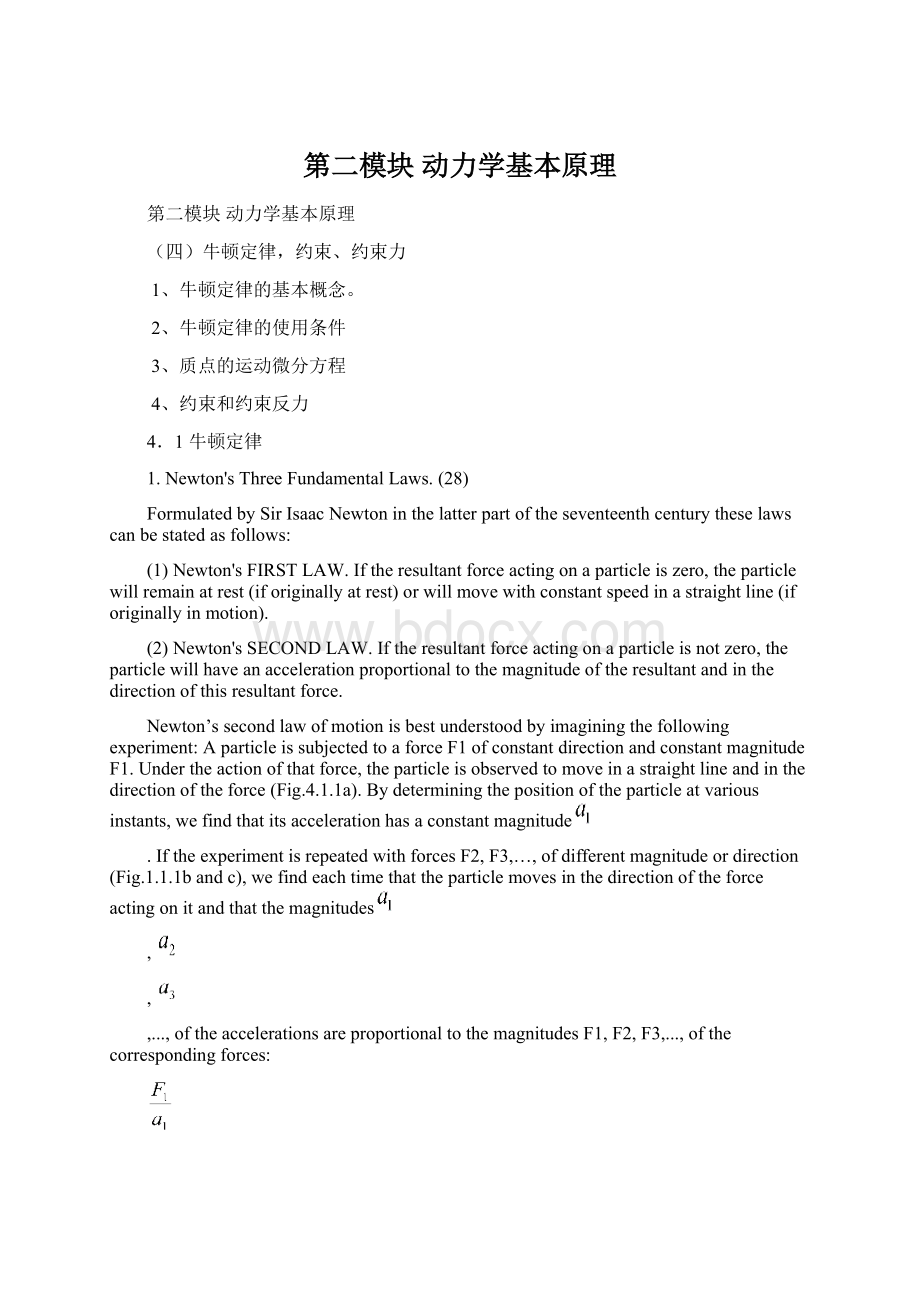 第二模块 动力学基本原理Word格式.docx
第二模块 动力学基本原理Word格式.docx
- 文档编号:20083018
- 上传时间:2023-01-16
- 格式:DOCX
- 页数:12
- 大小:277.08KB
第二模块 动力学基本原理Word格式.docx
《第二模块 动力学基本原理Word格式.docx》由会员分享,可在线阅读,更多相关《第二模块 动力学基本原理Word格式.docx(12页珍藏版)》请在冰豆网上搜索。

sSECONDLAW.Iftheresultantforceactingonaparticleisnotzero,theparticlewillhaveanaccelerationproportionaltothemagnitudeoftheresultantandinthedirectionofthisresultantforce.
Newton’ssecondlawofmotionisbestunderstoodbyimaginingthefollowingexperiment:
AparticleissubjectedtoaforceF1ofconstantdirectionandconstantmagnitudeF1.Undertheactionofthatforce,theparticleisobservedtomoveinastraightlineandinthedirectionoftheforce(Fig.4.1.1a).Bydeterminingthepositionoftheparticleatvariousinstants,wefindthatitsaccelerationhasaconstantmagnitude
.IftheexperimentisrepeatedwithforcesF2,F3,…,ofdifferentmagnitudeordirection(Fig.1.1.1bandc),wefindeachtimethattheparticlemovesinthedirectionoftheforceactingonitandthatthemagnitudes
...,oftheaccelerationsareproportionaltothemagnitudesF1,F2,F3,...,ofthecorrespondingforces:
=
=constant
Fig.4.1.1
Theconstantvalueobtainedfortheratioofthemagnitudesoftheforcesandaccelerationsisacharacteristicoftheparticleunderconsideration;
itiscalledthemassoftheparticleandisdenotedbym.WhenaparticleofmassmisacteduponbyaforceF,theforceFandtheaccelerationaoftheparticlemustthereforesatisfytherelation
F=ma(4.1.1)
ThisrelationprovidesacompleteformulationofNewton’ssecondlaw,itexpressesnotonlythatthemagnitudesofFandaareproportionalbutalso(sincemisapositivescalar)thatthevectorsFandahavethesamedirection(Fig.4.1.2).WeshouldnotethatEq.(4.1.1)stillholdswhenFisnotconstantbutvarieswithtimeinmagnitudeordirection.ThemagnitudesofFandaremainproportional,andthetwovectorshavethesamedirectionatanygiveninstant.However,theywillnot,ingeneral,betangenttothepathoftheparticle.
Fig.4.1.2
Whenaparticleissubjectedsimultaneouslytoseveralforces,Eq.(1.1.1)shouldbereplacedby
=ma(4.1.2)
where
representsthesum,orresultant,ofalltheforcesactingontheparticle,
(3)Newton'
sTHIRDLAW.Theforcesofactionandreactionbetweenbodiesincontacthavethesamemagnitude,samelineofaction,andoppositesense.
Foreveryaction,thereisanequalandoppositereaction;
thatis,theforcesofinteractionbetweentwoparticlesareequalinmagnitudeandoppositeindirection.
2、牛顿定律的使用条件
(1)在运动学中参考系可以任意选取,但在动力学中则不能任意选取参考系。
(2)惯性参考系:
与绝对静止空间固连的参考系以及相对其匀速直线平动的参考系。
牛顿定律适用于一切惯性参考系。
(3)伽利略相对性原理:
一切力学方程和定律对所有惯性参考系都是等价的。
3、质点的运动微分方程
向量式(牛顿第二运动定律)
4、约束和约束反力
(五)受力分析、受力图
物体的受力分析受力图
Thefree-bodydiagram(FBD)ofabodyisasketchofthebodyshowingallforcesthatactonit.Thetermfreeimpliesthatallsupportshavebeenremovedandreplacedbytheforces(reactions)thattheyexertonthebody.
在求解静力平衡问题时,必须首先分析物体的受力情况,即进行受力分析。
根据问题的已知条件和待求量,从有关结构中恰当选择某一物体(或几个物体组成的系统)作为研究对象。
这时,可设想将所选择的对象从与周围的约束(含物体)的接触中分离出来,即解除其所受的约束而代之以相应的约束反力。
这一过程称为解除约束。
解除约束后的物体,称为分离体,画有分离体及其所受的全部力(包括主动力和约束反力)的简图,称为受力图。
TheimportanceofmasteringtheFBDtechniquecannotbeoveremphasized.Free-bodydiagramsarefundamentaltoallengineeringdisciplinesthatareconcernedwiththeeffectsthatforceshaveonbodies.TheconstructionofanFBDisthekeystepthattranslatesaphysicalproblemintoaformthatcanbeanalyzedmathematically.
Forcesthatactonabodycanbedividedintotwogeneralcategories—reactiveforces(orsimplyreactions)andappliedforces.Reactionsarethoseforcesthatareexertedonabodybythesupportstowhichitisattached.Forcesactingonabodythatarenotprovidedbythesupportsarecalledappliedforcedofcourse,allforces,bothreactiveandapplied,mustbeshownonbe-bodydiagrams.
ThefollowingisthegeneralProcedureforconstructingafree-bodydiagram.
1.Asketchofthebodyisdrawnassumingthatallsupports(surfacesofcontact,supportingcables,etc.)havebeenremoved.
2.Allappliedforcesaredrawnandlabeledonthesketch.Theweighofthebodyisconsideredtobeanappliedforceactingatthecenterofgravity,thecenterofgravityofahomogeneousbodycoincideswiththecentroidofitsvolume.
3.Thereactionsduetoeachsupportaredrawnandlabeledonthesketch.(Ifthesenseofareactionisunknown,itshouldbeassumed.TheSolutionwilldeterminethecorrectsense:
Apositiveresultindicatesthattheassumedsenseiscorrect,whereasanegativeresultmeansthatthecorrectsenseisoppositetotheassumedsense.)
4.Allrelevantanglesanddimensionsareshownonthesketch.
WhenyouhavecompletedthisProcedure,youwillhaveadrawing(i.e.,abe-bodydrawing)thatcontainsalloftheinformationnecessaryforwritingtheequilibriumequationsofthebody.
ThemostdifficultsteptomasterintheconstructionofFBDsisthedeterminationofthesupportreactions.Table4.lshowsthereactionsexertedbyvariouscoplanarsupports;
italsoliststhenumberofunknownsthatareintroducedonanFBDbytheremovalofeachsupport.TobesuccessfulatdrawingFBDs,youmustbecompletelyfamiliarwiththecontentsofTable4.l.Itisalsohelpfultounderstandthephysicalreasoningthatdeterminesthereactionsateachsupport,whicharedescribedbelow.
画受力图是求解静力学问题的重要步骤。
Youshouldkeepthefollowingpointsinmindwhenyouaredrawingfree-bodydiagrams.
1.Beneat.Becausetheequilibriumequationswillbederiveddirectlyfromthefree-bodydiagram,itisessentialthatthediagrambereadable.
2.Clearlylabelallforces,angles,anddistanceswithvalues(ifknown)orsymbols(ifthevaluesarenotknown).
3.ThesupportreactionsmustbeconsistentwiththeinformationpresentedinTable4.l.
4.Showonlyforcesthatareexternaltothebody(thisincludessupportreactions).internalforcesoccurinequalandoppositepairsandthuswillnotappearonfree-bodydiagrams.
例5一1重量为G的梯子AB,搁在光滑的水平地面和铅直墙上。
在D点用水平绳索与墙相连,如图所示。
试画出梯子的受力图。
例5—2下图所示的结构有杆AC、CD与滑轮B铰接组成。
物体重W,用绳子挂在滑轮上。
如杆、滑轮及绳子的自重不计,并忽略各处的摩擦,试分别画出滑轮B(包括绳索)、杆AC、CD及整个系统的受力图。
在上例中,当取整个系统为研究对象时,AC杆与CD杆在C处不分开,此时这两根杆之间的相互作用力称为内力。
一般来说,当取某个系统为研究对象时,该系统内构件之间的内力都不必画出,而只画作用在系统上的外力。
需要指出的是,内力和外力的区分不是绝对的,在一定的条件下,内力和外力是可以相互转化的。
例如在上例中,如果要画由杆AC、滑轮B、重物和绳子所组成系统的受力图,则杆CD对杆AC的约束反力F’sc(原来整个系统中两杆之间的内力)就成了该系统的外力。
SampleProblem5.3
Thehomogeneous,250-kgtriangularplateinrig.(a)issupportedbyapinatAandarolleratC.DrawntheFBDoftheplateanddeterminethenumberofunknowns.
Solution
TheFBDoftheplateisshowninFig.(b).Thepinandrollersupportshavebeenremovedandreplacedbythereactiveforces.Theforcesactingonheplateredescribedbelow.
W:
TheWeightofthePlate
TheweightoftheplateisW=mg=(250)(9.81)=2453N.ItactsatthecentroidG.OnlythehorizontallocationofGisshowninthefigure,becauseitissufficienttodeterminethelineofactionofW.
AxandAy:
TheComponentsofthePinReactionatA
FromTable4.l,weseethatapinreactioncanbeshownastwocomponentsA.andAy,whichareequivalenttoanunknownforceactingatanunknownangle.WehaveshownAxactingtotherightandAyactingupward.Thesedirectionsarechosenarbitrarily;
thesolutionoftheequilibriumequationswilldeterminethecorrectsenseforeachforce.Therefore,thefree-bodydiagramwouldbecorrectevenifA.orAywerechosentoactindirectionsoppositetothoseshowninFig.(b).
NC:
TheNormalReactionatC
FromTable4.l,theforceexertedbyarollersupportisnormaltotheinclinedsurface.Therefore,ontheFBDweshowtheforceNCatC,inclinedat30otothevertical.
TheFBDcontainsthreeunknowns:
Ax,AyandNC
求解静力学问题,必须先画受力图。
如何有针对性地选取分离体并正确地画出受力图,是解题的关键。
它不仅在静力学中,而且在动力学中也很重要。
综上所述,要正确地画出受力图,必须熟练掌握以下几点:
(1)根据题意选择恰当的研究对象。
可以取单个物体为研究对象,也可以取由几个物体组成的系统为研究对象。
这一点在学习了用平衡方程求解力学问题后,会有更确切的体会。
(2)根据已知条件,画出全部主动力。
(3)根据约束的类型,画出相应的约束反力。
一个物体往往同时受几个约束的作用,应根据每个约束的特征确定约束反力的个数(一个力、两个正交分力或三个正交分力)和方位。
切不可凭主观臆测去推断约束反力的方位。
为此,可核对每一个所画出的约束反力,指出它是由哪个物体(施力体)施加的。
约束反力不能多画,也不能漏画。
(4)要熟练地使用规定的字母和符号标记各个力,对作用力和反作用力应注意它们的标记特征。
要按原结构图上各构件的尺寸和几何关系作图,以免引起错误。
(5)对系统中的二力杆应给予特别的注意。
必要时还应根据有关公理或推论对某些约束反力进行分析,并确定其方位。
(6)当以系统为研究对象时,受力图上只画研究对象所受的主动力和约束反力,而不画其成对出现的内力。
(六)虚位移原理。
1、基本概念
(1)真实位移—实际发生的位移,用dr表示,它同时满足动力学方程、初始条件和约束条件。
(2)可能位移—约束允许的位移,用Δr表示,它只需满足约束条件。
(3)虚位移—定常约束情况下的可能位移,非定常情况下假想约束“冻结”时的可能位移,用r表示。
2、例题
3、解题步骤
1.确定研究对象:
整体
2.约束分析:
是否理想约束?
3.受力分析:
Ø
求主动力之间的关系或平衡位置:
只画主动力
求约束反力:
解除约束,约束反力作为主动力
4.给出虚位移,找出它们之间的关系
几何法:
根据约束的几何关系,直接找出各点虚位移之间的关系
解析法:
选取适当的坐标系,写出约束方程并进行变分,即可求得各点的虚位移
5.列出虚功方程,并求解
- 配套讲稿:
如PPT文件的首页显示word图标,表示该PPT已包含配套word讲稿。双击word图标可打开word文档。
- 特殊限制:
部分文档作品中含有的国旗、国徽等图片,仅作为作品整体效果示例展示,禁止商用。设计者仅对作品中独创性部分享有著作权。
- 关 键 词:
- 第二模块 动力学基本原理 第二 模块 动力学 基本原理
 冰豆网所有资源均是用户自行上传分享,仅供网友学习交流,未经上传用户书面授权,请勿作他用。
冰豆网所有资源均是用户自行上传分享,仅供网友学习交流,未经上传用户书面授权,请勿作他用。


 对中国城市家庭的教育投资行为的理论和实证研究.docx
对中国城市家庭的教育投资行为的理论和实证研究.docx
